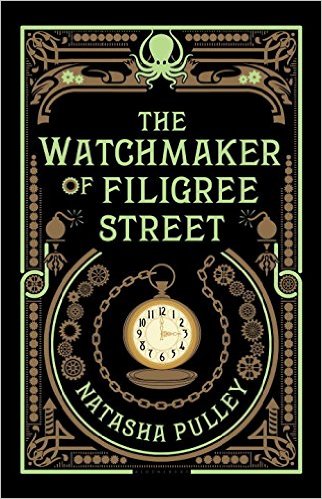
Dear All
Further good news for Natasha Pulley’s WATCHMAKER OF FILIGREE STREET, which has been selected by Kirkus Reviews as one of the Best Books of 2015: https://www.kirkusreviews.com/issue/best-of-2015/section/fiction/?page=10
I had also noticed the book on the below selections:
●The Amazon Best of the Books of the Month / SF& Fantasy
http://www.amazon.com/b/ref=s9_dnav_bw_BoSFF_b?_encoding=UTF8&node=4919319011&pf_rd_m=ATVPDKIKX0DER&pf_rd_s=merchandised-search-6&pf_rd_r=1976Y0SWWDGM721VG0YP&pf_rd_t=101&pf_rd_p=2121202602&pf_rd_i=390919011
●The ABA 2015 Summer/Fall Indies Introduce selection
http://www.bookweb.org/indies-introduce-summer-fall-2015
●An August IndieNext book
http://www.bookweb.org/news/august-2015-indie-next-list-preview
It was in The Best Books of the Month July selection.
Now the web page has been updated for August selection, but the book is still listed in "Science Fiction & Fantasy: Editors' Picks"!
http://www.amazon.com/s/ref=lp_4919319011_pg_3?rh=n%3A283155%2Cn%3A!2334088011%2Cn%3A!2334119011%2Cn%3A!16285081%2C
New York Times author interview
A Watchmaker’s Life
By SUSANNE FOWLER
NOV. 12, 2015
LONDON — Natasha Pulley’s debut novel, “The Watchmaker of Filigree Street,” takes readers inside a fantasy world that stretches from Tokyo to Scotland Yard. Driving the plot in her reimagined late-Victorian era are a rose-gold pocket watch and timepieces in the shapes of mechanical fireflies and an octopus.
Over pots of green tea at Lanka patisserie in South Hampstead in London, Ms. Pulley, 26, discussed the role of watches in her novel, published by Bloomsbury Circus in September, and in her own life. (This interview has been edited and condensed.)
Q. Tell us about the watchmaker, Keita Mori.
A. The most important thing about Mori is how he sees and perceives time. He remembers the future. Which means that as he arranges things, he is arranging time, which is exactly what watchmakers do.
Q. How did you get inside the mind of a watchmaker?
A. In very early drafts, Mori was a gunsmith but the more I read about watchmaking, the more appropriate it was. You have to be very careful and have small hands as well.
I once ordered a packet of clockwork, and tried to put one of them together. It’s the most fiddly, difficult thing. To have done it properly I would have needed a microscope.
Some of those cogs were so small I couldn’t pick them up.
Q. Did you visit or observe watchmakers?
A. I didn’t. I was a university student and didn’t have a lot of time. But I bought a book, “The Pocket Watch Handbook” by M. Cutmore. I found it on Amazon. The more I read about Victorian-era clockwork and what was going on then, the more fascinated I was.
In the book there is a character, a child named Six, whom Mori basically rents from a workhouse to make fusee chain of incredibly tiny links. That seems quite whimsical, but it really happened: Although the chain eventually became obsolete, it was still made in the workhouses by children as a way to supposedly stave off idleness.
Q. And is there a Filigree Street?
A. I think there might be one, but it’s not where I say it is. The Filigree Street in the book is just off Knightsbridge, by Harrods, and it is a fictional street.
I was sort of thinking of Turl Street in Oxford, this kind of beautiful cobbled street. And it’s got this kind of wonderful stationery shop called Scriptum, which has antlers and quill pens and ink bottles in the window.
I wanted something that was quite medieval and so I just dropped that into London.
Q. The cover design for the British hardback gives clues to the mysteries within — like a pocket watch, bombs threatening to explode and a curious green octopus.
A. I did a little dance of joy over that. Someone pointed out to me that the slightly strange green on the cover is radium green, which used to be used on watch hands.
Q. One of Mr. Mori’s creations is Katsu, a clockwork octopus. In one scene, Katsu, has been programmed to behave as if Mr. Mori were there because that was where Mr. Mori had planned to be. Are you telling us that life has too many variables, that planning is futile?
A. It wasn’t so much about planning but that even that someone who knows all about the possibilities can still be taken by surprise by something unlikely. You will always have outside chances.
I also liked the idea of changing something biological into something mechanical. Mori spends his time doing this, for the beauty of clockwork and what you can do with clockwork.
Or rather, what you could do with clockwork if you were Mori.
Q. So ‘‘like clockwork’’ isn’t quite the guarantee one might think?
A. The clockwork in the book is much more flexible than the clockwork of the time. And it’s made according to things that are much more like the algorithms of the future than the clockwork that we would recognize as being from the Victorian era. And I think to say ‘‘like clockwork’’ is interesting because while it can sometimes work very admirably, it was not a perfect measure of time at all. Many of those older clocks lost time every day.
Q. You’re not wearing a watch.
A. No. I have got a pocket watch. It was given to me, I think, on my 21st birthday and it is rose gold and it is the watch in the book. Given by my mum.
Q. Many people just check the time on their mobile phones.
A. Yes, I think you can compare it to the way the book business has changed. Watches are increasingly becoming luxury items, wonderful objects that you give people as presents. And that’s also happening to the book industry now. With e-books there’s no need to go out and buy the physical object, but people do. Publishers are giving books these wonderful covers, these wonderful designs, and they become a piece of furniture to have, much in the way of a Rolex. Telling time is something you can do that very easily on a mobile phone. But if you want a beautiful piece, that is what Rolex is for.